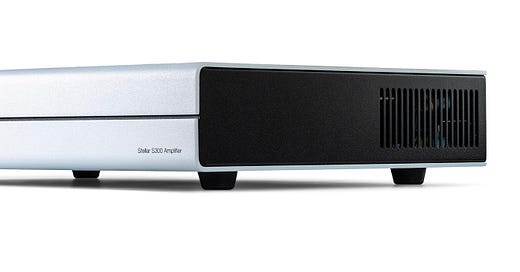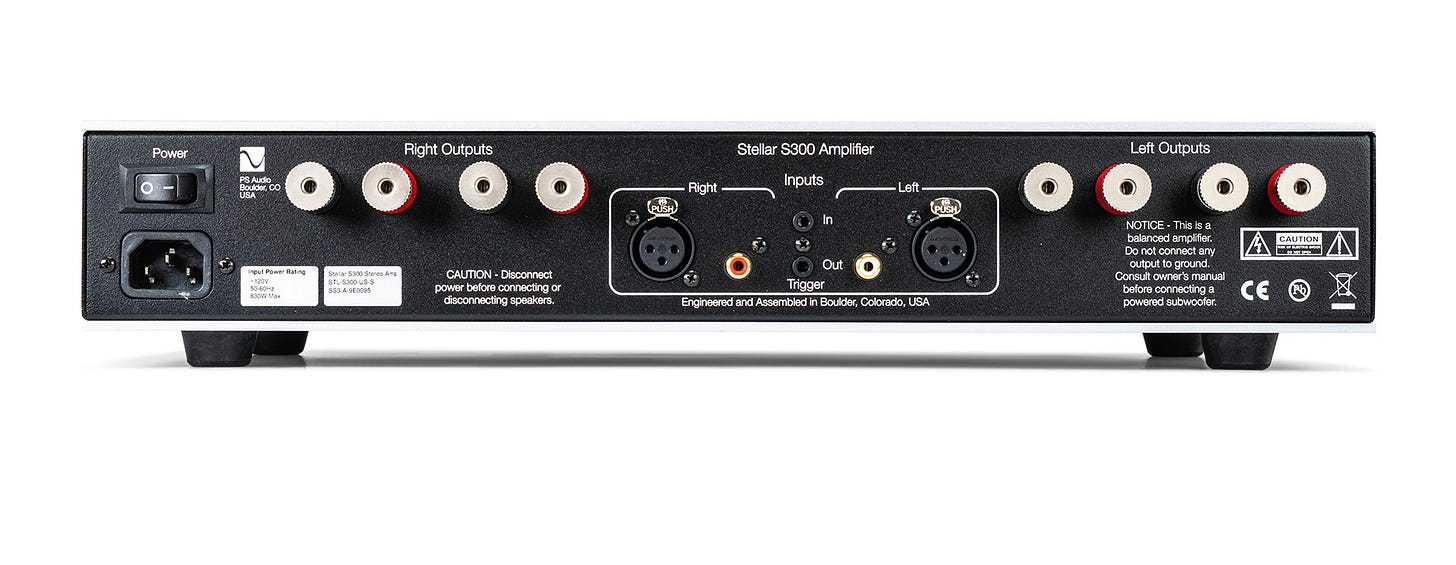No Apologies
When it appeared in Issue 313, I read colleague Jacob Heilbrunn’s review of the PS Audio M1200 monoblocks with interest and more than a little curiosity. Are you kidding me? Class D monoblocks driving Jacob’s $850k Wilson WAMM mega-system? And a highly favorably, to boot? In the article’s conclusion, JH didn’t mince words either. “Of the amplifiers that I’ve auditioned in this price range, the Stellar M1200 is by far the best, a gangbuster piece of gear that upends many old verities about switching amplification. I could live with it for a very long time. Stellar, indeed.” The cost for the amps? A piddling $6598 (gulp) a pair.
So, when I found myself in sudden need of a reasonably priced, 100Wpc stereo amplifier to review some recently received compact loudspeakers, I sought out PS Audio. Its team came up with the Stellar S300, the smaller stereo cousin to the mighty M1200 and also designed by PS Audio’s resident-wiz Darren Myers.
The Stellar S300 stereo power amplifier is a dual-mono design (separate power supplies and amp stages for each channel). It’s rated at 140 watts per channel into 8 ohms and 300Wpc into 4 ohms, and it’s based on a modern Class D ICE module, designed in Denmark. Like the M1200, it has a high damping factor for bass control and plenty of headroom for the difficult loads and lower sensitivities of some loudspeakers. As PS Audio points out, “Class D output stages provide near-perfect linearity, low distortion, and high efficiency. Because Class D amplifiers require an output filter to remove their switching noise, they do not have frequency extremes into the many hundreds of thousands of Hertz…modern Class D amplifiers, like the type used in Stellar, extend high frequencies to about 50kHz.” The input stage topology is known as the Analog Cell—a proprietary, fully differential, zero-feedback, discrete Class A MOSFET circuit. PS Audio makes no bones of the fact that it considers this hybrid design to be the best of both worlds. Note: S300’s Analog Cell input stage stands in contrast to the M1200 monoblocks, which have their own discrete tube input stage—a potentially significant difference.
The sleek, low-profile design of the S300 is matched by first-rate construction quality, a solidly assembled chassis with smooth rolled aluminum edges. The back panel features RCA and XLR inputs and a dual pair of high-quality nickel-over-copper speaker terminals. I listened to the S300 in a couple of system configurations. In one, it was driven by a Pass Labs XP-12 preamp and powered Vivid Audio Kaya 12 compact speakers. In another system, I enlisted the preamp section of the formidable Aesthetix Mimas integrated with the S300 driving the ATC SCM20SL compacts (with their low 84dB sensitivity). Power conditioning was from Audience and Shunyata. Cabling was Audience frontRow. Source components were by Lumin and dCS.
Like many audiophiles I’ve become accustomed to amplifiers of imposing girth and weight—the time-honored visual cues that signal power, dynamic headroom, stability, and (of course) heat. If you count yourself among this crowd, prepare for a little culture shock. With the S300 tipping the scales at a mere thirteen pounds and its compact chassis rising to all of three inches in height, you may not be ready to contend with the high level of performance, power, and finesse that the S300 is capable of.
The S300’s tonal balance is essentially neutral and colorless, in the best sense of those words. Rather than making itself the center of attention within the system, the S300 became a chameleon—a virtually invisible part of the chain of source components in front of it. In sonic performance, the word that immediately came to mind was contrasts—dynamic contrasts from the micro level to the macro. Music simply snapped into focus in full harmonic bloom. This amp was as fast and as explosive off the mark as any I’ve heard. This speed and power were combined with a bass-range grip that could send most other amps back to the gym. When the thundering kettle drums enter during Copland’s Fanfare, the S300 reproduced the tactile energy with an intensity that jolts the listener to attention. Remember, I said this amp was neutral, not boring.
As for timbral contrasts, the amp’s ability to define with certainty the character and personality of each musical element was in full-color display. Instrumental and vocal texture and timbre were reproduced with purity and clarity. The amp vividly portrayed the woody resonance of cello and bass violin, the crackle of a snare, the sharp song of a piccolo trumpet, the rattles of a tambourine, the grit of rosin from a cello bow, the clatter of a flat pick, a singer drawing a breath. In addition to its astonishing grip, the S300 had a sensitivity to low-level information like backing vocal harmonies or microdynamic shifts, right down to the duration of held-note sustains and reverberant decays from piano soundboards. It’s these contrasts that I would argue constitute a large portion of the live experience (and why the stone quiet of this amp is not only important but paramount). A favorite example is Ricki Lee Jones’ “I’ll Be Seeing You” [Pop Pop]. Here on full display was the eerie and airy naturalism of the clarinet, the soft resonance of the nylon-string guitar—the S300 seemed to hang on to the edges of every note and extend each decay. Prolonged sustain and decay was also handily evidenced during Laurel Masse’s brilliant acapella performances in the vast acoustic space of the Troy Savings Bank.
The S300’s entire sonic picture came into even sharper focus when I cued up David Bowie’s smash hit “Let’s Dance.” This explosive and complex multi-track is all about transient speed, rhythm section focus, dynamic impact, and a heavy, intense drumbeats, extending right down to the drummer’s foot pedal. The S300 wore its speed and rhythmic integrity like a badge of honor, making this cut leap forward, as if a nano-second ahead of the beat. Even if you never listened to the lengthier Euro 45rpm remix as I do, you’ll find the streaming version is also a stunning production. Co-produced with Nile Rodgers at the Power Station in New York, there’s the bonus of a blistering guitar solo by a youthful Stevie Ray Vaughn. And most of all, Bowie’s riveting, sensual, throaty vocal. “Under the serious moonlight,” indeed.
Towards the conclusion of this evaluation, I challenged the S300 a final time. Thanks to the generosity of MBL’s North American distributor (for which I’m forever grateful) I still had the remarkable MBL 126 compact Radialstrahlers on hand. And if there was an octave range where the S300 might show a little temperament, it would be through one of the most transparent midrange/tweeter combinations I’ve ever experienced. Few loudspeakers are more revealing of timbre and texture or as transparent and sensitive to low-level detail as these marvelous omnidirectional three-way compacts. However, they are sensitive to electronics, demanding accurate, reliable. and generous amounts of power. I typically drive them with MBL’s own Cadenza C51 180Wpc integrated ($9800), a Jürgen Reis-designed Linear Analog Switching Amplifier (LASA). The Stellar S300 put forth an excellent effort driving the Radialstrahlers. During larger scale brass and wind pieces like the sweeping Liberty Fanfare, they demonstrated superb command and control over the barrage of heavy percussion [Wilson Audio]. But in direct comparison, the S300 lacked the epic bass extension and hard-core slam of the MBL C51, a trademark of Reis designs. At the end of the day, the top end might have been a little drier, too, lacking the effortless harmonic bloom of the MBL amp. Nonetheless, the S300 put on an impressive show, to say the least.
A final word on Class D, if I may. Digital artifacts and colorations (the early rap was flat mids, brittle, snappish treble, deep but stiffly controlled bass) of an earlier era have been largely expunged from today’s top crop of Class D amps. Candidly, I don’t even know anymore what it means to describe a contemporary amp’s sonic signature as “Class D.” Yet, many of us still have a negative knee-jerk reaction to the “D” word. It’s rather like acknowledging a superb recording on vinyl, and then finding out the transfer wasn’t pure AAA analog and deciding it wasn’t up to snuff, after all. This is a long-winded way of saying, listen first before you judge. The era of apologizing for Class D is over.
To describe the PS Audio Stellar S300 as a “good” value is an understatement of the highest order. And with a retail price of $1649, I’m not joking when I initially thought this must be a typo. If you can’t get excited over an amp like the S300, you might reconsider your own high-end bona-fides—or check your pulse. Enthusiastically recommended without reservation.
Specs & Pricing
Type: Stereo, dual-mono, hybrid Class D power amplifier
Power output: 140Wpc 8 ohms, 300Wpc into 4 ohms
Inputs: RCA and XLR
Dimensions: 17** x 3** x 12**
Weight: 13 lbs.
Price: $1649






